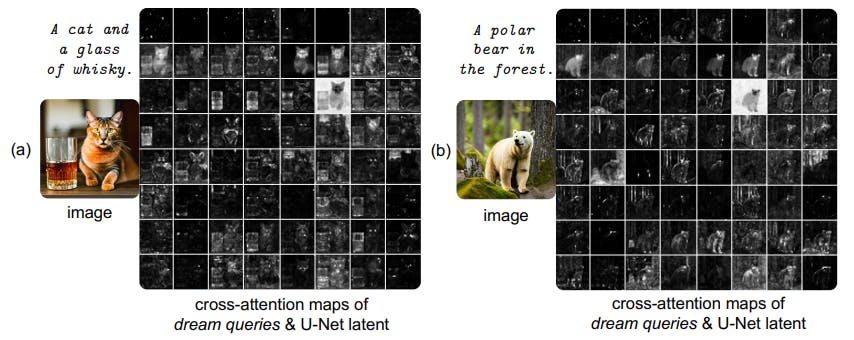
2024-11-28 06:11:26 Author: hackernoon.com(查看原文) 阅读量:1 收藏
Table of Links
2 Background & Problem Statement
2.1 How can we use MLLMs for Diffusion Synthesis that Synergizes both sides?
3.1 End-to-End Interleaved generative Pretraining (I-GPT)
4 Experiments and 4.1 Multimodal Comprehension
4.2 Text-Conditional Image Synthesis
4.3 Multimodal Joint Creation & Comprehension
5 Discussions
5.1 Synergy between creation & Comprehension?
5. 2 What is learned by DreamLLM?
B Additional Qualitative Examples
E Limitations, Failure Cases & Future Works
5.2 WHAT IS LEARNED BY DREAMLLM?
Dream Query Attention In DREAMLLM, the conditional embedding is derived from MLLMs with some learned dream queries. Fig. 6 demonstrates a visualization of the learned cross-attention mechanism between these queries and the diffusion latent. Similar to (Hertz et al., 2023), we visualize the attention map averaged across all timestamps. It is seen that: i) The query attention is structured, disentangled, and semantically-oriented.
This is evidenced by the fact that distinct queries adeptly capture different subject and background semantics. ii) Despite varying prompts, attention patterns exhibit remarkable similarity as shown in Fig. 6 (a) and (b). This contrasts with the token attentions from the original SD, which are typically text-token dependent. We postulate that this arises from the model’s causal nature, leading to a consistent semantic structure order.

Authors:
(1) Runpei Dong, Xi’an Jiaotong University and Internship at MEGVII;
(2) Chunrui Han, MEGVII Technology;
(3) Yuang Peng, Tsinghua University and Internship at MEGVII;
(4) Zekun Qi, Xi’an Jiaotong University and Internship at MEGVII;
(5) Zheng Ge, MEGVII Technology;
(6) Jinrong Yang, HUST and Internship at MEGVII;
(7) Liang Zhao, MEGVII Technology;
(8) Jianjian Sun, MEGVII Technology;
(9) Hongyu Zhou, MEGVII Technology;
(10) Haoran Wei, MEGVII Technology;
(11) Xiangwen Kong, MEGVII Technology;
(12) Xiangyu Zhang, MEGVII Technology and a Project leader;
(13) Kaisheng Ma, Tsinghua University and a Corresponding author;
(14) Li Yi, Tsinghua University, a Corresponding authors and Project leader.
如有侵权请联系:admin#unsafe.sh